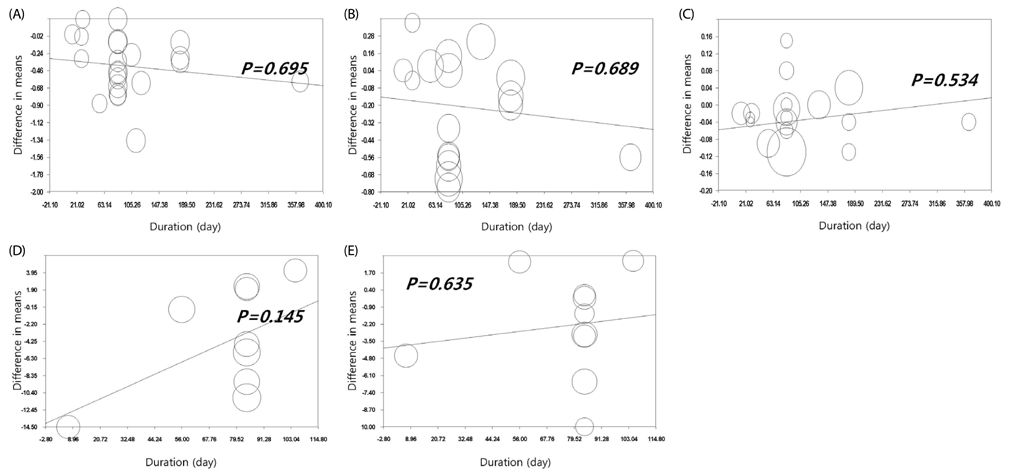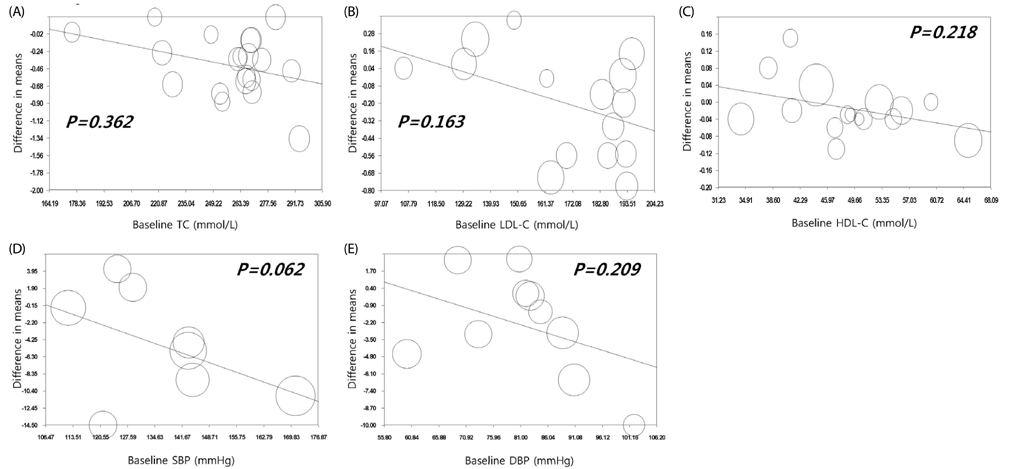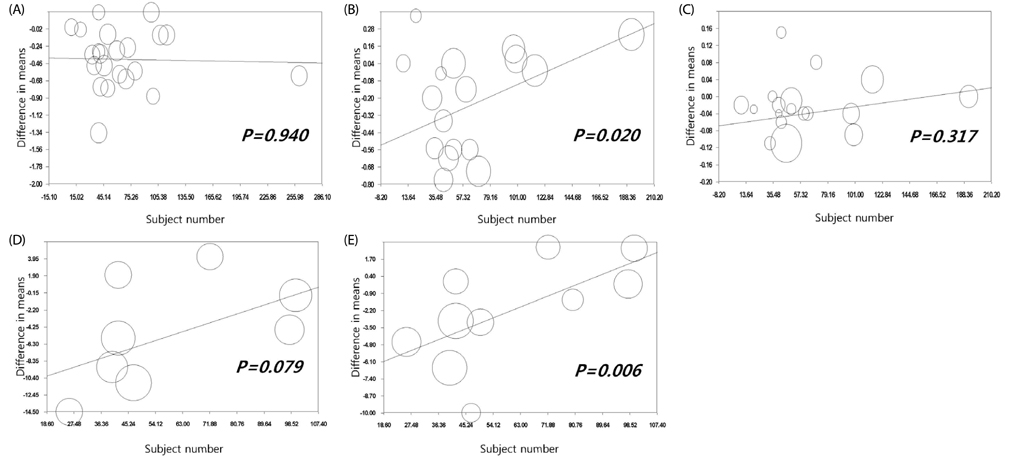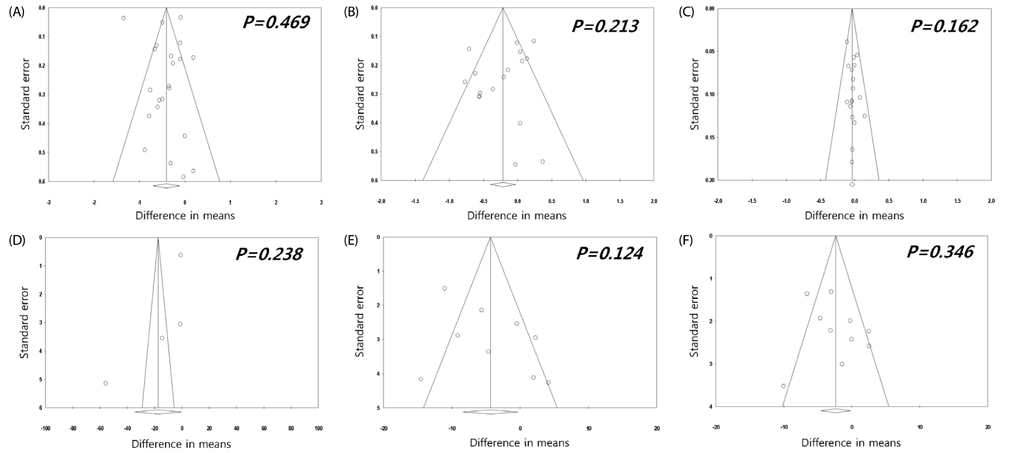Nutr Res Pract.
2014 Dec;8(6):644-654. 10.4162/nrp.2014.8.6.644.
Garlic powder intake and cardiovascular risk factors: a meta-analysis of randomized controlled clinical trials
- Affiliations
-
- 1Department of Nutritional Science and Food Management, Ewha Womans University, 52, Ewhayeodae-gil, Seodaemun-gu, Seoul 120-750, Korea. orank@ewha.ac.kr
- 2Department of Food Science and Technology, Seoul National University of Science and Technology, Seoul 139-743, Korea.
- 3Department of Agrofood Resources, Rural Development Administration, Jeonbuk 565-851, Korea.
- 4BioFood Network, Ewha Womans University, 52, Ewhayeodae-gil, Seodaemun-gu, Seoul 120-750, Korea.
- KMID: 2313791
- DOI: http://doi.org/10.4162/nrp.2014.8.6.644
Abstract
- BACKGROUND/OBJECTIVES
Although preclinical studies suggest that garlic has potential preventive effects on cardiovascular disease (CVD) risk factors, clinical trials and reports from systematic reviews or meta-analyses present inconsistent results. The contradiction might be attributed to variations in the manufacturing process that can markedly influence the composition of garlic products. To investigate this issue further, we performed a meta-analysis of the effects of garlic powder on CVD risk factors.
MATERIALS/METHODS
We searched PubMed, Cochrane, Science Direct and EMBASE through May 2014. A random-effects meta-analysis was performed on 22 trials reporting total cholesterol (TC), 17 trials reporting LDL cholesterol (LDL-C), 18 trials reporting HDL cholesterol (HDL-C), 4 trials reporting fasting blood glucose (FBG), 9 trials reporting systolic blood pressure (SBP) and 10 trials reporting diastolic blood pressure (DBP).
RESULTS
The overall garlic powder intake significantly reduced blood TC and LDL-C by -0.41 mmol/L (95% confidence interval [CI], -0.69, -0.12) (-15.83 mg/dL [95% CI, -26.64, -4.63]) and -0.21 mmol/L (95% CI, -0.40, -0.03) (-8.11 mg/dL [95% CI, -15.44, -1.16]), respectively. The mean difference in the reduction of FBG levels was -0.96 mmol/L (95% CI, -1.91, -0.01) (-17.30 mg/dL [95% CI, -34.41, -0.18]). Evidence for SBP and DBP reduction in the garlic supplementation group was also demonstrated by decreases of -4.34 mmHg (95% CI, -8.38, -0.29) and -2.36 mmHg (95% CI, -4.56, -0.15), respectively.
CONCLUSIONS
This meta-analysis provides consistent evidence that garlic powder intake reduces the CVD risk factors of TC, LDL-C, FBG and BP.
MeSH Terms
Figure
Cited by 1 articles
-
Effect of cassia cinnamon intake on improvement of the glycemic response: An updated meta-analysis: Focus on preparation of dehydrated powder and water extract
Jin Sook Kwak, Min young Park, Oran Kwon
J Nutr Health. 2017;50(5):437-446. doi: 10.4163/jnh.2017.50.5.437.
Reference
-
1. World Health Organization. World Heart Federation; World Stroke Organization. Global Atlas on Cardiovascular Disease Prevention and Control. Geneva: World Health Organization;2011.2. Verschuren WM, Jacobs DR, Bloemberg BP, Kromhout D, Menotti A, Aravanis C, Blackburn H, Buzina R, Dontas AS, Fidanza F, Karvonen MJ, Nedelijković S, Nissinen A, Toshima H. Serum total cholesterol and long-term coronary heart disease mortality in different cultures. Twenty-five-year follow-up of the seven countries study. JAMA. 1995; 274:131–136.
Article3. Amagase H. Clarifying the real bioactive constituents of garlic. J Nutr. 2006; 136:716S–725S.
Article4. Ried K, Toben C, Fakler P. Effect of garlic on serum lipids: an updated meta-analysis. Nutr Rev. 2013; 71:282–299.
Article5. Silagy CA, Neil HA. A meta-analysis of the effect of garlic on blood pressure. J Hypertens. 1994; 12:463–468.
Article6. Zeng T, Guo FF, Zhang CL, Song FY, Zhao XL, Xie KQ. A metaanalysis of randomized, double-blind, placebo-controlled trials for the effects of garlic on serum lipid profiles. J Sci Food Agric. 2012; 92:1892–1902.
Article7. Khoo YS, Aziz Z. Garlic supplementation and serum cholesterol: a meta-analysis. J Clin Pharm Ther. 2009; 34:133–145.
Article8. You SJ, Ahn BK, Kang CW. Effects of dietary garlic powder on growth performance and mRNA expression of hepatic HMG-CoA reductase in broiler chickens. J Anim Sci Technol. 2009; 51:307–314.
Article9. Kim-Park S, Ku DD. Garlic elicits a nitric oxide-dependent relaxation and inhibits hypoxic pulmonary vasoconstriction in rats. Clin Exp Pharmacol Physiol. 2000; 27:780–786.
Article10. Al-Qattan KK, Thomson M, Al-Mutawa'a S, Al-Hajeri D, Drobiova H, Ali M. Nitric oxide mediates the blood-pressure lowering effect of garlic in the rat two-kidney, one-clip model of hypertension. J Nutr. 2006; 136:774S–776S.
Article11. Adler AJ, Holub BJ. Effect of garlic and fish-oil supplementation on serum lipid and lipoprotein concentrations in hypercholesterolemic men. Am J Clin Nutr. 1997; 65:445–450.
Article12. Anim-Nyame N, Sooranna SR, Johnson MR, Gamble J, Steer PJ. Garlic supplementation increases peripheral blood flow: a role for interleukin-6? J Nutr Biochem. 2004; 15:30–36.
Article13. Ashraf R, Aamir K, Shaikh AR, Ahmed T. Effects of garlic on dyslipidemia in patients with type 2 diabetes mellitus. J Ayub Med Coll Abbottabad. 2005; 17:60–64.14. Ashraf R, Khan RA, Ashraf I. Garlic (Allium sativum) supplementation with standard antidiabetic agent provides better diabetic control in type 2 diabetes patients. Pak J Pharm Sci. 2011; 24:565–570.15. Auer W, Eiber A, Hertkorn E, Hoehfeld E, Koehrle U, Lorenz A, Mader F, Merx W, Otto G, Schmid-Otto B. Hypertension and hyperlipidaemia: garlic helps in mild cases. Br J Clin Pract Suppl. 1990; 69:3–6.16. Byrne DJ, Neil HA, Vallance DT, Winder AF. A pilot study of garlic consumption shows no significant effect on markers of oxidation or sub-fraction composition of low-density lipoprotein including lipoprotein(a) after allowance for non-compliance and the placebo effect. Clin Chim Acta. 1999; 285:21–33.
Article17. Gardner CD, Lawson LD, Block E, Chatterjee LM, Kiazand A, Balise RR, Kraemer HC. Effect of raw garlic vs commercial garlic supplements on plasma lipid concentrations in adults with moderate hypercholesterolemia: a randomized clinical trial. Arch Intern Med. 2007; 167:346–353.
Article18. Holzgartner H, Schmidt U, Kuhn U. Comparison of the efficacy and tolerance of a garlic preparation vs. bezafibrate. Arzneimittelforschung. 1992; 42:1473–1477.19. Isaacsohn JL, Moser M, Stein EA, Dudley K, Davey JA, Liskov E, Black HR. Garlic powder and plasma lipids and lipoproteins: a multicenter, randomized, placebo-controlled trial. Arch Intern Med. 1998; 158:1189–1194.20. Jain AK, Vargas R, Gotzkowsky S, McMahon FG. Can garlic reduce levels of serum lipids? A controlled clinical study. Am J Med. 1993; 94:632–635.
Article21. Kannar D, Wattanapenpaiboon N, Savige GS, Wahlqvist ML. Hypocholesterolemic effect of an enteric-coated garlic supplement. J Am Coll Nutr. 2001; 20:225–231.
Article22. Kiesewetter H, Jung F, Jung EM, Blume J, Mrowietz C, Birk A, Koscielny J, Wenzel E. Effects of garlic coated tablets in peripheral arterial occlusive disease. Clin Investig. 1993; 71:383–386.
Article23. Lash JP, Cardoso LR, Mesler PM, Walczak DA, Pollak R. The effect of garlic on hypercholesterolemia in renal transplant patients. Transplant Proc. 1998; 30:189–191.
Article24. Mader FH. Treatment of hyperlipidaemia with garlic-powder tablets. Evidence from the German Association of General Practitioners' multicentric placebo-controlled double-blind study. Arzneimittelforschung. 1990; 40:1111–1116.25. Neil HA, Silagy CA, Lancaster T, Hodgeman J, Vos K, Moore JW, Jones L, Cahill J, Fowler GH. Garlic powder in the treatment of moderate hyperlipidaemia: a controlled trial and meta-analysis. J R Coll Physicians Lond. 1996; 30:329–334.26. Phelps S, Harris WS. Garlic supplementation and lipoprotein oxidation susceptibility. Lipids. 1993; 28:475–477.
Article27. Rahmani M, Tabari AK, Niaki K, Allahaverdian S, Sheikholeslami M. Effect of dried garlic supplementation on blood lipids in mild and moderate hypercholesterolemic patients. Arch Iran Med. 1999; 2:19–23.28. De A, Gruenwald J. Effect of garlic powder tablets on blood lipids and blood pressure: a six month placebo controlled, double blind study. Br J Clin Res. 1993; 4:37–44.29. Saradeth T, Seidl S, Resch KL, Ernst E. Does garlic alter the lipid pattern in normal volunteers? Phytomedicine. 1994; 1:183–185.
Article30. Sitprija S, Plengvidhya C, Kangkaya V, Bhuvapanich S, Tunkayoon M. Garlic and diabetes mellitus phase II clinical trial. J Med Assoc Thai. 1987; 70:Suppl 2. 223–227.31. Sobenin IA, Andrianova IV, Demidova ON, Gorchakova T, Orekhov AN. Lipid-lowering effects of time-released garlic powder tablets in double-blinded placebo-controlled randomized study. J Atheroscler Thromb. 2008; 15:334–338.
Article32. Sobenin IA, Nedosugova LV, Filatova LV, Balabolkin MI, Gorchakova TV, Orekhov AN. Metabolic effects of time-released garlic powder tablets in type 2 diabetes mellitus: the results of double-blinded placebo-controlled study. Acta Diabetol. 2008; 45:1–6.
Article33. Sobenin IA, Pryanishnikov VV, Kunnova LM, Rabinovich YA, Martirosyan DM, Orekhov AN. The effects of time-released garlic powder tablets on multifunctional cardiovascular risk in patients with coronary artery disease. Lipids Health Dis. 2010; 9:119.
Article34. Superko HR, Krauss RM. Garlic powder, effect on plasma lipids, postprandial lipemia, low-density lipoprotein particle size, high-density lipoprotein subclass distribution and lipoprotein(a). J Am Coll Cardiol. 2000; 35:321–326.
Article35. Vorberg G, Schneider B. Therapy with garlic: results of a placebo-controlled, double-blind study. Br J Clin Pract Suppl. 1990; 69:7–11.36. Ziaei S, Hantoshzadeh S, Rezasoltani P, Lamyian M. The effect of garlic tablet on plasma lipids and platelet aggregation in nulliparous pregnants at high risk of preeclampsia. Eur J Obstet Gynecol Reprod Biol. 2001; 99:201–206.
Article37. Reinhart KM, Talati R, White CM, Coleman CI. The impact of garlic on lipid parameters: a systematic review and meta-analysis. Nutr Res Rev. 2009; 22:39–48.
Article38. Staba EJ, Lash L, Staba JE. A commentary on the effects of garlic extraction and formulation on product composition. J Nutr. 2001; 131:1118S–1119S.
Article39. D'Agostino RB Sr, Grundy S, Sullivan LM, Wilson P. CHD Risk Prediction Group. Validation of the Framingham coronary heart disease prediction scores: results of a multiple ethnic groups investigation. JAMA. 2001; 286:180–187.40. Wilson PW, D'Agostino RB, Levy D, Belanger AM, Silbershatz H, Kannel WB. Prediction of coronary heart disease using risk factor categories. Circulation. 1998; 97:1837–1847.
Article41. Kim JA, Montagnani M, Koh KK, Quon MJ. Reciprocal relationships between insulin resistance and endothelial dysfunction: molecular and pathophysiological mechanisms. Circulation. 2006; 113:1888–1904.
Article42. Moher D, Liberati A, Tetzlaff J, Altman DG. PRISMA Group. Preferred reporting items for systematic reviews and meta-analyses: the PRISMA statement. BMJ. 2009; 339:b2535.
Article43. Higgins JP, Green S. Cochrane handbook for systematic reviews of interventions. Version 5.1.0 [Internet]. Oxford: The Cochrane Collaboration;2011. updated 2011 March. cited 2014 June 1. Available from: www.cochrane-handbook.org.44. Kim JY, Kwon O. Garlic intake and cancer risk: an analysis using the Food and Drug Administration's evidence-based review system for the scientific evaluation of health claims. Am J Clin Nutr. 2009; 89:257–264.
Article45. Zeng T, Zhang CL, Zhao XL, Xie KQ. The roles of garlic on the lipid parameters: a systematic review of the literature. Crit Rev Food Sci Nutr. 2013; 53:215–230.
Article46. Rahman K, Lowe GM. Garlic and cardiovascular disease: a critical review. J Nutr. 2006; 136:736S–740S.
Article47. Roberts WC. Atherosclerotic risk factors--are there ten or is there only one? Am J Cardiol. 1989; 64:552–554.
Article48. Ried K, Frank OR, Stocks NP, Fakler P, Sullivan T. Effect of garlic on blood pressure: a systematic review and meta-analysis. BMC Cardiovasc Disord. 2008; 8:13.
Article49. Reinhart KM, Coleman CI, Teevan C, Vachhani P, White CM. Effects of garlic on blood pressure in patients with and without systolic hypertension: a meta-analysis. Ann Pharmacother. 2008; 42:1766–1771.
Article
- Full Text Links
- Actions
-
Cited
- CITED
-
- Close
- Share
- Similar articles
-
- Effect of garlic (Allium sativum L.) as a functional food, on blood pressure: a meta-analysis of garlic powder, focused on trials for prehypertensive subjects
- Prophylactic efficacy of probiotics on travelers' diarrhea: an adaptive meta-analysis of randomized controlled trials
- Effects of garlic intake on cancer: a systematic review of randomized clinical trials and cohort studies
- Effect of cassia cinnamon intake on improvement of the glycemic response: An updated meta-analysis: Focus on preparation of dehydrated powder and water extract
- Vitamin D and Risk of Respiratory Tract Infections in Children: A Systematic Review and Meta-analysis of Randomized Controlled Trials











